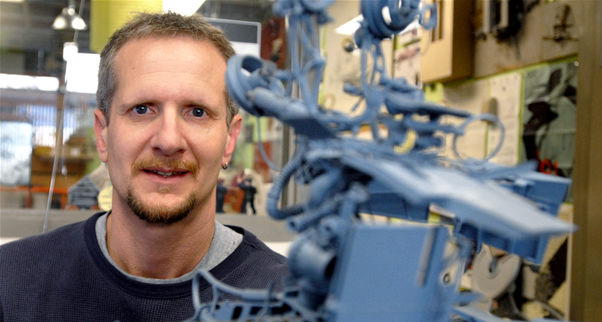Everywhere But Inside the 'Box'
Theoretical Architect Bryan Cantley's Projects Ask — and Explore — Questions
January 14, 2008
By Gail Matsunaga
Talk about thinking outside the box: an “urban outhouse” that collapses when the occupant exits; an altar device that computerizes reactions of participants; and, more recently, a floating mobile cityscape that provides additional public spaces.
Such are some of the concepts that Bryan W. Cantley — professor of art — has envisioned over the years as a theoretical architect. In addition to teaching 3D design, he also runs his own architectural studio Form:uLA.
Q: What is a theoretical architect and how would you describe
what it is you do?
A: A colleague suggested that a theoretical architect is an artist whose
medium is that of architecture. I think that’s true to some extent,
but it’s also someone who has been trained as an architect — who
understands what architecture is and how it is conducted, as well as
realizes that architecture is a very large discipline with many facets.
And manages to utilize several of these in the exploration of one component
or more. I believe the medium of the architect is space. In that sense,
any exploration — whether “real” or “theoretical” — is
in fact architecture.
Architecture can be divided into two schools of thought: “solving problems” and “asking questions.” At times, the two align — which tends to make clients very happy. At other times, they collide and even usurp each other. I’d say that the aforementioned projects do both, but are weighted much heavier in the latter. I have been criticized before — and rightly so! — that I often answer questions that have not been asked. So is the spirit of intellectual inquiry — and my passion for the quest and passion within academics.
So I tend to get interested in projects that have a different “box” altogether.
Q: What’s an urban outhouse and what is the idea behind
it?
A: The outhouse addressed the problem of a lack of public facilities
in urban environments. The idea that we have “deviant space” — where
unsavory acts take place — in all cities, and especially in the
then-public toilets of Europe, led my partner and I to the idea that
this space could simply “go away” after its use. Hence, the
outhouse folds out of itself to be used. After a time limit — occupants
vacant of course! — it automatically cleans, then literally folds
back into itself, thus removing the opportunity for deviant space to
exist.
Q: What is the concept behind the mobile cityscape?
A: The mobile cityscape allowed me to address the issues of dwindling
parks and open space in our cities — even on our campus — and
gave me the opportunity to explore high technology and how that might
manifest in a truly mobile architecture.
It’s an entity that travels from location to location that becomes a floating civic plaza and lightly programmed support spaces that never have a single given place. It would travel where needed, and leave when immediate need was quenched. In essence, it has the potential to exist in many places, or rather any place, at any given time. It is both site-less and of many-sites. It lies somewhere between the idea of mobility and multi-spatiality. Since the urban setting is often defined by the fabric of public open space, I saw this as an opportunity to allow critical need to determine architectural experimentation.
It’s not a project of the now, but rather one that challenges urban and architectural thought of when. I feel that the future of architecture is important to consider before we actually get there.
Q: What are you currently working on?
A: Two books — my own monograph on the digital paper projects I’ve
been working on for six years. The second, “Contemporary Visionary
Architecture,” is an international survey of visionary works that
are conducted mainly in traditional media.
I’ll be at Macworld 08, Apple’s annual conference this week, where I’m presenting on my digital paper projects and exploring the use of tablets — computers without mouse or keyboard, where one draws directly on the screen.
I’m also teaching a green architecture studio at Woodbury University this spring, and writing and laying drum tracks for a CD with my band.


